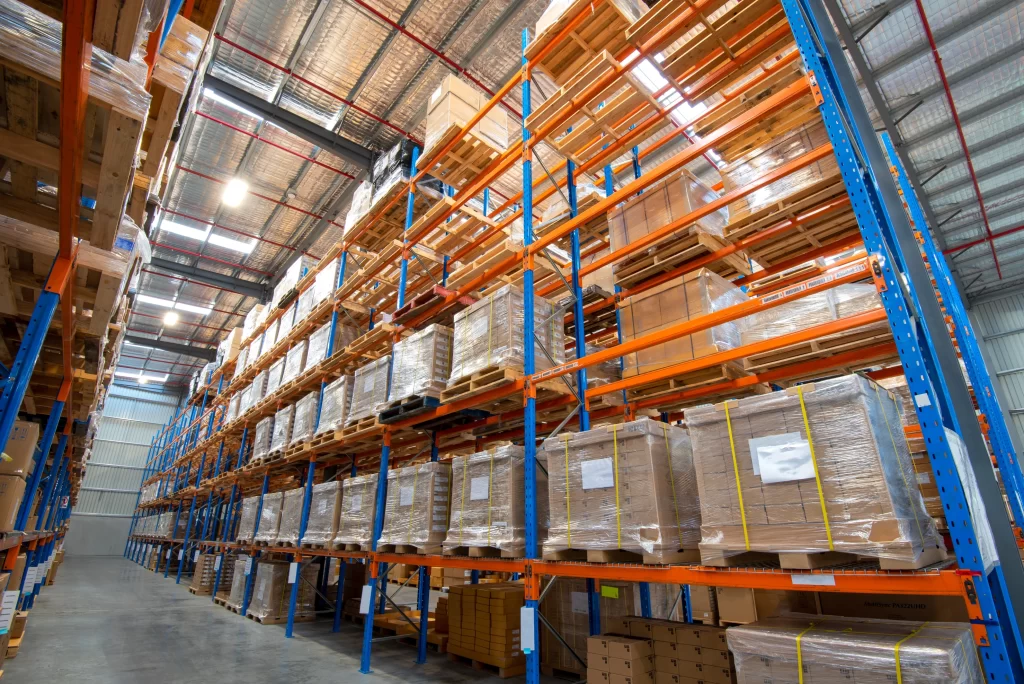In the fast-paced world of logistics and warehousing, efficiency and organization are paramount. That’s where pallet racks come in. These versatile storage solutions play a crucial role in maximizing space and ensuring smooth operations. Whether you’re managing a small warehouse or a large distribution center, understanding the ins and outs of pallet racks can significantly improve your storage capabilities. In this guide, we’ll walk you through everything you need to know about industrial pallet racks.

What Are Pallet Racks?
Pallet racks are storage systems designed to hold and organize pallets, which are flat transport structures that support goods in a stable manner. These racks are commonly used in warehouses, manufacturing facilities, and retail centers to store inventory efficiently. Pallets themselves can be made of wood, plastic, or metal and are typically used with forklifts to move goods around.
Pallet racks come in various configurations, allowing businesses to choose the best system for their specific needs. The primary goal of these racks is to maximize vertical storage space while maintaining easy access to all stored items. This makes them an essential component of modern warehousing and inventory management.
In addition to their practical benefits, pallet racks are also highly customizable. They can be adjusted or reconfigured to accommodate different types of products and storage requirements, making them a versatile solution for various industries.
Types of Pallet Racks
Selective Pallet Racks
Selective pallet racks are the most common type of pallet racking system. These racks allow for direct access to each pallet, making them ideal for businesses with a high turnover rate or a wide variety of products. The design consists of uprights and beams that create individual storage spaces for each pallet.
One of the main advantages of selective pallet racks is their flexibility. They can be easily adjusted to accommodate different pallet sizes and weights, making them suitable for various storage needs. Additionally, they are relatively simple to install and maintain, which is a significant benefit for busy warehouses.
However, selective pallet racks do require more aisle space compared to other systems, which can limit overall storage density. Despite this drawback, their ease of use and versatility make them a popular choice for many businesses.
Drive-In and Drive-Through Racks
Drive-in and drive-through racks are designed for high-density storage. These systems allow forklifts to enter the rack structure to place and retrieve pallets, reducing the need for multiple aisles. Drive-in racks have one entry and exit point, while drive-through racks have entry points on both ends.
These racks are ideal for businesses that store large quantities of similar products, as they maximize storage density. However, they operate on a first-in, last-out (FILO) basis, which means that the first pallet placed is the last one retrieved. This can be a limitation for businesses that need to access specific pallets frequently.
Despite the FILO limitation, drive-in and drive-through racks are highly efficient for bulk storage. They help optimize space utilization, making them a valuable addition to any high-density storage environment.
Push-Back Racks
Push-back racks are another high-density storage solution that operates on a last-in, first-out (LIFO) basis. These racks use inclined rails and nested carts, allowing pallets to be stored on multiple levels. When a pallet is loaded, it pushes the previous pallet back, creating a cascading effect.
One of the key advantages of push-back racks is their ability to store multiple pallets deep while still providing easy access to each level. This makes them ideal for businesses with a high inventory turnover and limited space. Additionally, push-back racks can be integrated with selective pallet racks for added versatility.
However, push-back racks are more complex and expensive compared to other systems. They require careful maintenance to ensure smooth operation, but the benefits of increased storage density and accessibility often outweigh these challenges.
Pallet Flow Racks
Pallet flow racks, also known as gravity flow racks, use a combination of gravity and rollers to move pallets from the loading end to the picking end. These racks operate on a first-in, first-out (FIFO) basis, making them ideal for businesses that need to manage inventory with expiration dates, such as food and pharmaceuticals.
The main advantage of pallet flow racks is their ability to provide high-density storage while maintaining efficient inventory rotation. This ensures that older stock is used first, reducing the risk of waste or spoilage. Additionally, these racks can be customized with speed controllers and braking systems to manage the flow of pallets.
However, pallet flow racks are more complex to install and maintain compared to selective or drive-in racks. They require regular inspections to ensure the rollers and braking systems are functioning correctly. Despite these challenges, their efficiency and FIFO capabilities make them a valuable asset for many industries.
Cantilever Racks
Cantilever racks are designed for storing long, bulky items such as lumber, pipes, and furniture. These racks consist of vertical columns with horizontal arms that extend outward, providing support for the items. Cantilever racks are highly versatile and can be adjusted to accommodate different lengths and weights.
One of the main advantages of cantilever racks is their open design, which allows for easy loading and unloading of items. This makes them ideal for businesses that handle large or awkwardly shaped products. Additionally, cantilever racks can be configured as single-sided or double-sided, depending on the available space and storage needs.
However, cantilever racks are not suitable for storing standard pallets, which limits their use in traditional warehousing environments. Despite this limitation, their ability to store long items efficiently makes them an essential tool for many industries.

Benefits of Using Pallet Racks
Maximizing Storage Space
One of the primary benefits of using pallet racks is the ability to maximize storage space. By utilizing vertical space effectively, businesses can store more products in a smaller footprint. This is especially important for warehouses and distribution centers with limited floor space.
Pallet racks also provide easy access to stored items, allowing for efficient inventory management. This reduces the time and effort required to locate and retrieve products, improving overall productivity. Additionally, the ability to adjust and reconfigure racks ensures that businesses can adapt to changing storage needs.
Improving Inventory Management
Efficient inventory management is crucial for any business, and pallet racks play a significant role in achieving this. By organizing products systematically, businesses can easily track inventory levels and reduce the risk of stockouts or overstocking. This ensures that products are readily available when needed, improving customer satisfaction.
Pallet racks also facilitate the implementation of inventory management systems, such as barcode scanning and RFID technology. These systems provide real-time visibility into inventory levels, enabling businesses to make informed decisions and optimize their supply chain operations.
Enhancing Safety
Safety is a top priority in any warehouse or storage facility, and pallet racks contribute to a safer working environment. By storing products off the ground and in a secure manner, pallet racks reduce the risk of accidents and injuries. This is particularly important for businesses that handle heavy or bulky items.
Additionally, pallet racks can be equipped with safety features such as column protectors, rack guards, and safety netting to prevent products from falling and causing damage or injury. Regular inspections and maintenance ensure that the racks remain in good condition and continue to provide safe storage.
Increasing Efficiency
Pallet racks are designed to enhance operational efficiency by providing easy access to stored items. This reduces the time and effort required to locate and retrieve products, improving overall productivity. Additionally, the ability to store products systematically enables businesses to implement efficient picking and packing processes.
The use of pallet racks also supports the implementation of automated systems, such as conveyor belts and automated storage and retrieval systems (ASRS). These systems streamline warehouse operations, reducing labor costs and improving accuracy.
Customizable and Scalable
One of the key advantages of pallet racks is their versatility. These racks can be customized to accommodate different types of products and storage requirements. Businesses can choose from various configurations, such as selective, drive-in, push-back, pallet flow, and cantilever racks, depending on their specific needs.
Additionally, pallet racks are scalable, allowing businesses to expand their storage capacity as needed. This flexibility ensures that the storage system can grow with the business, providing long-term value and return on investment.
Conclusion
Pallet racks are a crucial component of modern warehousing and inventory management. By maximizing storage space, improving inventory management, enhancing safety, increasing efficiency, and providing customizable solutions, pallet racks offer numerous benefits to businesses across various industries.
Whether you’re managing a small warehouse or a large distribution center, understanding the different types of pallet racks and their applications can help you choose the best system for your needs. By investing in high-quality pallet racks and maintaining them regularly, you can optimize your storage capabilities and ensure smooth operations for years to come.
Ready to take your storage solutions to the next level? Visit our website to learn more about our range of pallet racks and how we can help you improve your warehouse operations.
